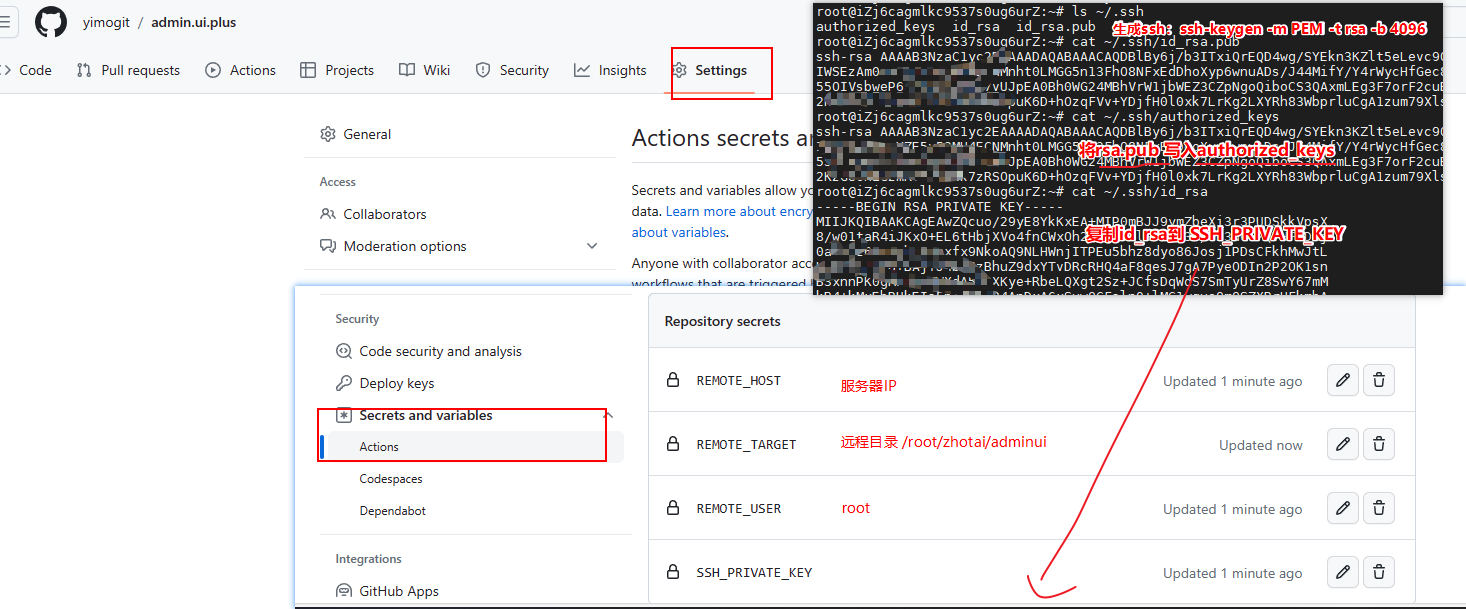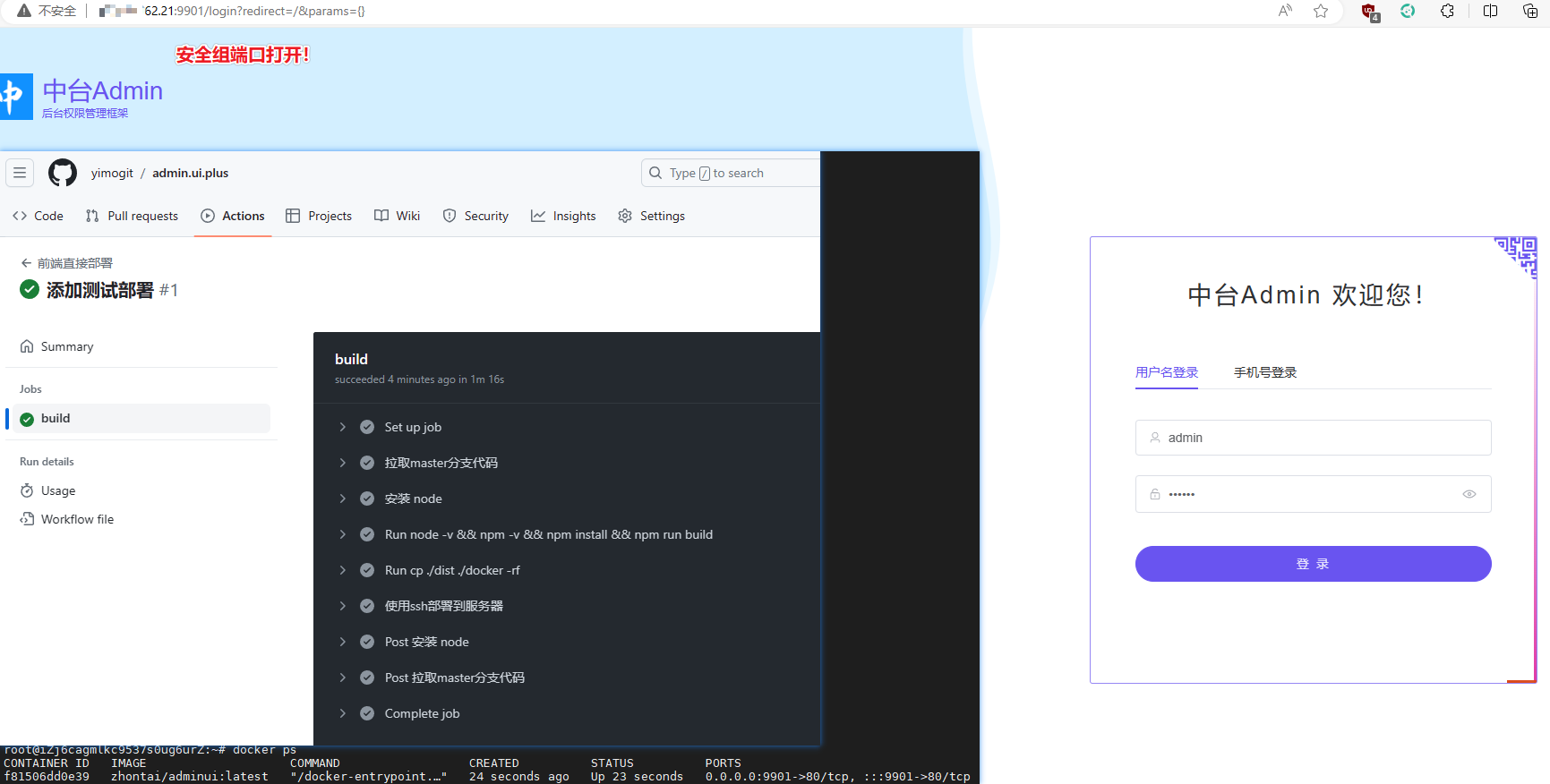Github Actions是什么?是 GitHub 提供的一种持续集成/持续部署(CI/CD)工作流程自动化服务,助力项目的自动化构建、测试和部署。
依托于平台,本文将分享使用 GitHub Actions 完成对一个.Net Core+Vue 的前后端分离项目 zhontai 的构建,并使用 docker 部署到云服务器(阿里云)
经过一番尝试学习,个人感受是其功能齐全,文档完善,使用 GitHub 托管仓库完成自己的 CI/CD,不再需要自己搞构建服务了。
关于使用费用问题:每个用户/组织都有免费的使用额度:2000 分钟/月, 不同的项目归类到不同的组织,完全足够使用了。
.github\workflows\test-deploy.yml├─.github
│ └─workflows
│ └─test-deploy.yml
├─docker
│ ├─Dockerfile
│ - publish_output publish生成的文件会复制到此,rsync上传到linux服务器
├─src
│ ├─hosts
├─...
复制新建 github actions 配置文件: .github\workflows\test-deploy.yml
on: workflow_dispatch 指定手动构建拉取分支
actions/checkout@v3安装 Dotnet7
actions/setup-dotnet@v3执行打包生成 publish_output 目录
dotnet publish ./src/hosts/ZhonTai.Host -c Release -o ./publish_output --self-contained true --runtime linux-x64 --framework net7.0使用 ssh 部署到服务器
easingthemes/ssh-deploy@v4.1.8mkdir /root/zhontai/volumns/upload -pdocker run --name my-zhontai-apihost -d -p 9902:8000 -e -v /root/zhontai/volumns/admindb.db:/app/admindb.db -v /root/zhontai/volumns/upload:/app/wwwroot/upload zhontai/apihost:latestssh 使用需要配置的环境变量
${{ secrets.SSH_PRIVATE_KEY }}:服务器的 ssh 密钥:~/.ssh/id_rsa 内容${{ secrets.REMOTE_HOST }}:服务器 IP: xxx.xxx.xxx.xxx${{ secrets.REMOTE_USER }}:用户名 root${{ secrets.REMOTE_TARGET }}:远程目录 /root/zhontai/api配置需要的环境变量

ssh-keygen -m PEM -t rsa -b 4096 生成 ssh,然后复制公钥到 authorized_keys构建完成

# test-deploy.yml
name: 后端测试环境直接部署
# 手动构建
#on: workflow_dispatch
on:
push:
branches:
- master
jobs:
build:
runs-on: ubuntu-latest
steps:
# 拉取仓库文件
- name: 拉取master分支代码
uses: actions/checkout@v3
with:
# 默认当前分支
ref: 'master'
# action命令,安装Dotnet7
- name: 安装 Dotnet7
uses: actions/setup-dotnet@v3
with:
dotnet-version: 7.0.400
# 执行打包命令
- run: dotnet --version && dotnet publish ./src/hosts/ZhonTai.Host -c Release -o ./publish_output --self-contained true --runtime linux-x64 --framework net7.0
# 将dist复制到docker目录中
- run: cp ./publish_output ./docker -rf
# 使用 ssh 将api-dist文件拷贝到 linux
- name: 使用ssh部署
uses: easingthemes/ssh-deploy@v4.1.8
with:
SSH_PRIVATE_KEY: ${{ secrets.SSH_PRIVATE_KEY }}
ARGS: '-rlgoDzvc -i --delete'
SOURCE: 'docker'
REMOTE_HOST: ${{ secrets.REMOTE_HOST }}
REMOTE_USER: ${{ secrets.REMOTE_USER }}
TARGET: ${{ secrets.REMOTE_TARGET }}
EXCLUDE: '/node_modules/'
SCRIPT_BEFORE: |
mkdir ${{ secrets.REMOTE_TARGET }} -p
SCRIPT_AFTER: |
cd ${{ secrets.REMOTE_TARGET }}
cd docker
docker build --rm -f ./Dockerfile -t zhontai/apihost:latest .
# 检查容器是否存在
if docker container ls -a | grep -q "my-zhontai-apihost"; then
echo "容器已存在"
# 停止并移除容器
docker stop my-zhontai-apihost
docker rm my-zhontai-apihost
fi
# 容器挂载的路径
mkdir /root/zhontai/volumns/upload -p
docker run --name my-zhontai-apihost -d -p 9902:8000 -e ASPNETCORE_ENVIRONMENT=Testing -v /root/zhontai/volumns/admindb.db:/app/admindb.db -v /root/zhontai/volumns/upload:/app/wwwroot/upload zhontai/apihost:latest
复制# 使用 ASP.NET Core 运行时镜像作为最终镜像 FROM mcr.microsoft.com/dotnet/aspnet:7.0 AS runtime WORKDIR /app # 复制构建好的应用程序文件 COPY ./publish_output /app # 设置运行时环境变量 ENV ASPNETCORE_URLS=http://+:8000 # 指定容器启动时要执行的命令 ENTRYPOINT ["dotnet", "ZhonTai.Host.dll"]复制
整个过程类似镜像构建一样,一步步设置自己需要的环境,然后执行命令或者设置对应的操作,可以在使用前过一遍中文文档有个大概的了解,本文就跳过基础介绍直接说实现方式及重点
.github\workflows\test-deploy.yml├─.github
│ └─workflows
│ └─test-deploy.yml
├─docker
│ ├─Dockerfile
│ └─nginx.conf
│ - dist build生成的dist会复制到此,rsync上传到linux服务器
├─public
├─src
├─...
复制新建 github actions 配置文件: .github\workflows\test-deploy.yml
on: workflow_dispatch 指定手动构建拉取分支
actions/checkout@v3安装 node v18.17.1
actions/setup-node@v3执行打包生成 dist 目录
npm install && npm run buildnpm run build --mode testing 指定环境 testing,并使用 .env.testing 环境变量文件echo -e "\nVITE_API_URL=${{ secrets.API_HOST }}" >> .env.production 将配置中的 API_HOST 写入环境变量中使用 ssh 部署到服务器
easingthemes/ssh-deploy@v4.1.8ssh 使用需要配置的环境变量
${{ secrets.SSH_PRIVATE_KEY }}:服务器的 ssh 密钥${{ secrets.REMOTE_HOST }}:服务器 IP${{ secrets.REMOTE_USER }}:用户名${{ secrets.REMOTE_TARGET }}:远程目录${{ secrets.API_HOST }}: 接口地址,配置后写入VITE_API_URL=xxx.com配置需要的环境变量

ssh-keygen -m PEM -t rsa -b 4096 生成 ssh,然后复制公钥到 authorized_keys构建完成

# test-deploy.yml
name: 前端直接部署
# 手动构建
# on: workflow_dispatch
# 自动构建
on:
push:
branches:
- master
jobs:
build:
runs-on: ubuntu-latest
steps:
# 拉取仓库文件
- name: 拉取master分支代码
uses: actions/checkout@v3
with:
# 默认当前分支
ref: 'master'
# action命令,安装Node v18.17.1
- name: 安装 node
uses: actions/setup-node@v3
with:
node-version: 18.17.1
cache: 'npm'
# 执行打包命令
- run: |
if [ -n "${{ secrets.API_HOST }}" ]; then
# 使用设置中的接口地址
echo -e "\nVITE_API_URL=${{ secrets.API_HOST }}" >> .env.production
fi
- run: node -v && npm -v && npm install && npm run build
# 将dist复制到docker目录中
- run: cp ./dist ./docker -rf
# 使用 ssh 将dist文件拷贝到 linux
- name: 使用ssh部署到服务器
uses: easingthemes/ssh-deploy@v4.1.8
with:
SSH_PRIVATE_KEY: ${{ secrets.SSH_PRIVATE_KEY }}
ARGS: '-rlgoDzvc -i --delete'
SOURCE: 'docker'
REMOTE_HOST: ${{ secrets.REMOTE_HOST }}
REMOTE_USER: ${{ secrets.REMOTE_USER }}
TARGET: ${{ secrets.REMOTE_TARGET }}
EXCLUDE: '/node_modules/'
SCRIPT_BEFORE: |
mkdir ${{ secrets.REMOTE_TARGET }} -p
SCRIPT_AFTER: |
cd ${{ secrets.REMOTE_TARGET }}
cd docker
docker build --rm -f ./Dockerfile -t zhontai/adminui:latest .
# 检查容器是否存在
if docker container ls -a | grep -q "my-zhontai-adminui"; then
echo "容器已存在,停止并移除容器"
docker stop my-zhontai-adminui
docker rm my-zhontai-adminui
fi
docker run --name my-zhontai-adminui -d -p 9901:80 zhontai/adminui:latest
复制docker build --rm -f ./Dockerfile -t zhontai/adminui:latest .FROM nginx:1.18 EXPOSE 80 COPY ./dist /usr/share/nginx/html COPY ./nginx.conf /etc/nginx/conf.d/default.conf复制
server { listen 80; server_name localhost; charset utf-8; location / { root /usr/share/nginx/html; try_files $uri $uri/ /index.html; index index.html index.htm; } #error_page 404 /404.html; error_page 500 502 503 504 /50x.html; location = /50x.html { root html; } }复制
不完全踩坑记录
echo -e "\nVITE_API_URL=xxx" >> .env.production时间过得太快了,周末两天第一次沉下心研究了一天Github Actions,各种尝试踩坑,第二天将过程整理分享出来,写完这句,发现眨眼间就周一了。
似乎学习,能让我在迷茫中找到些许方向吧。
By 易墨 转载请注明出处
如果对部署的项目感兴趣可以参考前两篇文章